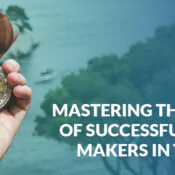Managing Complexity in a Complex Environment

Managing Complexity in a Complex Environment
In a study done by Gartner on 50 companies who experienced project failure, it was found that the common denominator was the refusal to address complexity in business processes.
Before diving into how you can cope with complexity, there’s an important differentiation we have to make when defining this concept. As Hank Barnes puts it, there are two reasons why we find ‘something’ to be complex. Either because we think it is complicated or because it is hard to understand. When it is the former, it is because we understand the process and involved factors and there’s opportunity to improve by simplifying what has become complicated. When is the latter, we usually find ourselves dealing with a new situation that we know little about.
Complexity - Complicated
Let’s tackle the first part: complicatedness. As Yves Morieux uncovered, organisations are a myriad of KPIs, rules, and silos that hinder productivity and innovation. Over the past 60 years, organisational complicatedness has increased in a factor of 35x while corporate requirements have increased in a factor of 6x. According to a survey done by the Boston Consulting Group, the amount of procedures, acceptance gates and vertical layers - among others - in large companies has increased between 50% to 350% over a 15 year period with customers demanding lower prices and higher quality while companies are striving to innovate and be more efficient.
Even reading that was complex, wasn’t it?
For dealing with complexity due to complicatedness, I find Morieux’s approach to be spot on. He claims that instead of trying to re-organise and impose new rules and processes, employers should instead look to empower their employees to increase engagement. This in turn will have a positive impact in performance, innovation and competitive advantage. An environment where communication and collaboration are at its core; where creativity flourishes and is ripe to tackle complex challenges. In short: get rid of the procedural complicatedness so that you can get some work done.
Below are Morieux’s Six Smart Simplicity Rules:
1) Understand what your coworkers do
- Understand the goals and challenges other people need to meet and the constraints they worked under.
- Observe and interact. Don’t just read their job duties.
Outcome: Empathy. Stop the blaming on lack of skills. Start questioning the organisations constraints and resources.
2) Reinforce the people who are integrators
- Those who enable the communication channels to foster cooperation between your “backstage” (R&D) and “frontline” offices (customer facing).
- Remove layers, use a flat hierarchy approach; give everyone a voice.
- Have less rules - keep it simple.
Outcome: collaboration between departments to jointly deliver business value. Increase in productivity.
3) Expand the amount of power available
- Empower the people to use their judgement.
- They will then take the risk to cooperate and move outside the box.
Outcome: increase in employee engagement.
4) Increase the need of reciprocity
- Expand the responsibilities of integrators outside their direct control area to achieve end-results.
- Reduce the amount of available resources; foster interaction and overlaps.
- Eliminate monopolies.
Outcome: Perception of richer goals and drive to resolve them.
5) Accelerate feedback loops
- Expose the ‘consequence of your actions’ sooner.
- Make them accountable, mindset shift: “if what I am developing today fails, it should be me who will need to address those issues and not someone else tomorrow.”
Outcome: increased accountability and quality.
6) Reward those who cooperate
- And counsel those who don't.
- When something goes wrong, don’t point at the unit that failed but rather at those that didn’t collaborate to help to fix it.
Outcome: increase in performance.
**Morieux also has a great TEDx talk on this subject that is worth watching.
Complexity - Difficult
Now let’s look at complexity due to its difficultness to be understood which can be generally defined by two factors: level of unknowns and level of volatility the requirements can go through once the project starts.
A high level of unknowns and volatility is the sweet spot for Scrum as we use an empirical process to figure things out as we go and keep improving on what we learn and also anticipating what we still don’t know based on previous experiences. The more we do it, the better we get at dealing with complexity and uncertainty. And you know what’s the best part about it? Complexity uncovers opportunities.
It is important to mention that Agile does not address complexity directly, but rather works well in scenarios where uncertainty is the word of the day. At its core, it works with no hierarchies, organisation structures or business strategies. It relies on self-organising teams that work in a near-chaos environment which are quick to adapt and re-strategize on the go while staying focused on the end goal. Agile is all about observation, experimentation, reflection and improvement. See what works and what doesn’t. Inspect and adapt, inspect and adapt.
A key ingredient of tackling this type of complexity is teamwork. A high degree of collaboration is the jumping off point to start questioning the unknowns, clearing away assumptions, and identifying patterns that could aid into understanding the “situation” we are facing. In my previous post, I talked about the importance of diversity within organisations. And here’s where I emphasize it even more: in order to tackle the most complex issues, you need to have and integrate very different points of views. Having a healthy team environment in which knowledge sharing, willingness to fail, learn and improve is what’s going to get your project over the line and succeed.
So there you have it.
Two ways of managing complexity in our very complex business world. One is to reduce complicatedness by following the six smart simplicity rules where people understand what their co-workers do, are empowered to make decisions and all the unnecessary clutter is removed. The second one is to handle difficulty by adopting an Agile framework like Scrum where inspecting and adapting will work well with uncertainty and expose risks along the way, ensuring that the right decisions are made at the right time.
Overall, instead of prescribing behaviours, foster an environment where motivated and engaged behaviours can occur. And if you don’t know where to begin as the project is difficult to understand (call us) and adopt Scrum where collaboration and adaptation will help to uncover what is really required. More than anything, build a safe environment for individuals and teams to learn from their mistakes. Stay away from micromanagement and complex business processes that add unnecessary overhead. Trust in the team and the team will get it done.
References
- Moore, S. (July 17, 2015) IT Projects Need Less Complexity Not More Governance.
- Yves Morieux, TED Talk and Also HBR publication (April 2014)
- Yves Morieux, Smart Rules: Six Ways to Get People to Solve Problems Without You
- Yves Morieux, TED talk
- Dyer, L. D. & Ericksen, J. (2008). Complexity-based agile enterprises: Putting self-organizing emergence to work (CAHRS Working Paper #08-01). Ithaca, NY: Cornell University, School of Industrial and Labor Relations, Center for Advanced Human Resource Studies. Deloitte (April 2017)
- Unravelling complexity: The challenge of compliance in the life sciences supply chain
- Alami, A. (Nov. 22, 2015) Can Agile Reduce Complexity?















